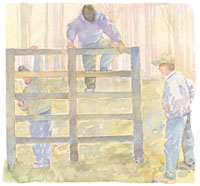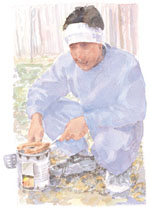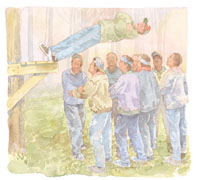![]() March-April 1999
March-April 1999
By Thomas C. Bolland
Illustrations by Richard Sparks
Boy Scouts wait with anticipation around a tower, the finish of a grueling camp obstacle course.

"Runner coming!" shouts a leader from the other end of the course. "On your mark, get set, go!"
A lithe figure dodges through the trees, rapidly maneuvering through, over, and around obstacle after obstacle. But the course takes its toll; nearing the finish, the Scout is tiring fast.
He reaches the tower, struggles to the top, and rings a bell, then collapses to the ground to catch his breath.
A Scout leader checks his stopwatch. "Two minutes, 43 seconds. Excellent job!" Still, the youth sits dejectedly. "I should have had the record," he says.
The leader pats the boy on the back. "You did good," he says. "Not bad for your first try."
At first glance, this looks like an ordinary Scout troop on a winter outing. But the boys camping in the cold February woods on this day are part of a special unit in the BSA's Heart of Ohio Council Juvenile Diversion Program.
Most of the Scouts have been ruled as unruly offenders by the Lorain County (Ohio) juvenile courts. An unruly child, by definition, is one who, among other things, does not subject himself or herself to the reasonable control of his or her parents or legal guardian, or who violates a law that is applicable only to children. Such children are often brought to the attention of the juvenile court because their parents don't know what to do with them.
Many such youth are disaffected with their families, schools, and communities. They lack the ability to identify positive and attainable goals. Many end up being charged in juvenile court.
The Lorain County Juvenile Court responded to this social condition with a coordinated effort of 16 community resources, including Scouting. The program includes prevention, intervention, and therapy that addresses the needs of children and parents.
The court asked the Heart of Ohio Council to develop a positive alternative to youth entering the juvenile justice system (which can result in probation or detention).
Specifically, the program should meet the need for developing greater self-confidence and decision-making skills in unruly youth.
The council's juvenile diversion program was devised by Bonnie Kerpics, a former senior Exploring executive. The Lorain County courts asked for a way to help juvenile offenders, and Kerpics put together a program based on a similar concept in Omaha.
However, the Nebraska effort utilized the Exploring program, while Kerpics's initial version involved traditional Boy Scouting.
When a youth comes to the attention of the juvenile court, the county prosecutor's office considers several things, including age of the youth, severity of the offense, and any prior criminal history of the youth. The office then sends a referral to the juvenile diversion office and the family is contacted by letter.
An interview is set up with the youth and his or her parents and the youth is given the option of participating in the program or having the case returned to the county prosecutor's office.
If the youth and his or her parents agree to participate in the program, they sign a contract outlining their part in the diversion agreement.
The youth is enrolled in a special troop. Parents agree to support the program, and the youth agrees to participate in meetings and service projects and to respect other participants.
Weapons, controlled substances, and gang-related clothing and insignia are forbidden. If the youth successfully completes the six-month program, the charges are dropped.
Scouting is just one of several groups involved with juvenile diversion, but it is easy to see why the court turned to the local BSA council. Juvenile diversion hopes to improve a youth's self-image, social skills, and attitude about the legal system. It also aims to teach better methods of communication.
Scouting's values-based program develops character, leadership, citizenship, and fitness. For older teens, Exploring - now called Venturing - focuses on six areas of development: leadership, citizenship, fitness, outdoor, service, and social. The program works to provide leadership experience and ideals and examples that lead to good character. It also works to train youth in the responsibilities of leadership and to teach skills in dealing with family members and others.

The Scout program "presents opportunities for discovery, contribution, initiative, resourcefulness, creativity, and the rediscovery of peers with each new experience, and appeals to the sensitivity as well as the temperament of these children," wrote Patricia Jacobs, director of the Lorain County Court Diversion Program.
"Additionally, the positive social experience of Scouting offers an alternative to the antisocial behavior of groups and gangs which promote excitement through negative risk experiences," she said.
David Keller, program director of the Heart of Ohio Council's juvenile diversion program, tries to de-emphasize what brought the kids to the program and emphasize that they are Scouts.
"They hike around, spill their food, and wrestle in the road just like anyone else," says Keller. "They all have this 'background,' and if you can get beyond that background, you can reach out to them. And that's what we've been able to do."
Children labeled as "unruly" are "impervious to rules, constantly pushing boundaries, and are controlling in their homes," Patricia Jacobs observed. In the Scouting program, their "unruly" traits "are channeled positively in the experience, manifesting as leadership, arbitrational skills, creative abilities, and survival skills."
"One mother mentioned that we aren't as strict as the regular Boy Scouts," says Miriam Covert, a corrections officer and Scoutmaster of Troop 960. "You can't be. A lot of the kids have problems with authority as it is.
"It's a very big accomplishment to get them to wear their Scout shirts and tuck them in, because they're from the streets," she says. "They want to prove they're big and tough and they don't want to be told anything."
Keller agrees. "We can tell them what to do the whole meeting and not get anything accomplished. We can't affect them if they aren't here."
Each youth is required to attend a specific number of meetings and to participate in community service hours and weekend activities.
Meetings focus on such topics as developing character, thinking critically and making wise decisions, problem-solving, and communicating effectively.
Weekend activities include participation in educational and social projects, and involvement in sports, outdoor activities, and community projects.
The boys work on Boy Scout advancement; go on day hikes, overnight camp-outs, and service projects; and participate in the teamwork-developing and self-confidence-building activities on the council's COPE (Challenging Outdoor Personal Experience) course.
Jacobs says many of the boys go in kicking, but once they are in, they enjoy the program.
"It's a lot different than I thought it would be," says one of the boys. "I was in the Cub Scouts when I was younger, but in this they're doing things I like to do." He says he particularly enjoyed the COPE activities.

Participating in outdoor activities, particularly those on the ropes and wooden structures of the COPE course, is a new experience for the boys. They must use teamwork to overcome many challenges, including climbing over (and helping their teammates over) a beam suspended eight feet above the ground. Other COPE confidence-building activities include sliding down a zip wire, crossing an aerial skywalk, and executing a six-foot "trust fall" into the arms of waiting teammates.
COPE activities are especially helpful, Keller says, because many of the boys have problems with trust.
"Outside in the woods is a new environment for them and I think they grow from it," he notes, adding that their experiences also teach valuable lessons. On one outing, for example, the Scouts went deep into the woods looking for dead tree limbs for firewood - a good use of discovery skills. But they overlooked suitable wood on the ground around the campsite.
Then they tried to light a pile of heavy logs rather than starting with tinder and kindling. "It was a learning experience for them," Keller explains. "They didn't have to go searching for what they really needed for the fire, and then they needed to start small and build up to a larger fire."
Troop 930, whose members are repeat offenders, is on a typical overnight camp-out. After chopping wood for the campfire, the boys hike over to try the camp's obstacle course. Back at the campsite, their leaders show them how to cook aluminum foil dinners. Around the campfire they share rap songs, then finish the evening with games of flashlight tag.
The Scouts in Troop 930 live at Stepping Stones, a residential treatment center for adjudicated juvenile felons. About half of the youth are associated with gangs and most come from dysfunctional families. The facility provides alcohol and drug treatment, anger management, and family therapy.
The Scout program helps youth learn about the environment and helps them deal with their anger, observes Luis Quinones, a child care worker at Stepping Stones. "The activities help motivate them and get them interested in other things than just hanging around."
Fewer program participants are becoming repeat offenders. Some continue in Scouting with regular troops after their mandatory six months.
"I've always liked hiking and camping," says one boy in Troop 960 who wants to continue in Scouting. "I like helping the other kids, too."
Another boy says he also hopes to transfer to a regular troop. "I want to be a Scout leader," he says.
Girls were included in juvenile diversion's second year when the program incorporated Exploring activities.
Jacobs was so impressed with the program's initial results that she asked Keller about developing something for girls who were unruly offenders.
As a result, Keller formed Post 951. He combined elements of Exploring, Learning for Life, and rank advancement, modifying them to meet the needs of the participants.
The girls learn outdoor skills and earn awards that are specific to the program. "We go on camp-outs and learn about nature," says one post member.
Another young woman expresses an appreciation for the program's wholesome aspects, calling it "good, sober fun." Even though she is now over 18, she continues to come to the unit meetings to help out.
There are three units in the Boy Scout juvenile diversion program. Troop 960 is designed for boys who are unruly offenders, Troop 930 is for the boys at Stepping Stones, and Post 951 is designed for girls who are unruly offenders. The units range in size from 5 to 15 members, except for the Stepping Stones troop, which usually has 20 to 25 members.
The program is about making the right choices, says Keller. "Today so many things can drag kids down the wrong path. They come to a fork in the road and don't have the tools to make the right decisions. We try to give them those tools."
Freelance writer Thomas C. Bolland lives in Athens, Ohio.
A Program That WorksOne result gives an indication that Scouting offers the kind of program that meets the needs of juvenile diversion. Although several groups participated in the initial Lorain County effort, the Heart of Ohio Council's program was the only one to last the full six-month trial period. Public funding for juvenile diversion programs comes from a state grant provided by the RECLAIM Ohio Program (Recent and Equitable Community and Local Alternatives to Incarceration of Minors). It was started by the office of then-Ohio Governor George Voinovich in conjunction with the Department of Youth Services. Counties work with offenders to prevent them from entering the court system. Funding for the Stepping Stones troop, however, comes from Lorain County Court. For more information, contact: Ted Hicks |
| The Boy Scouts of America | http://www.scouting.org |